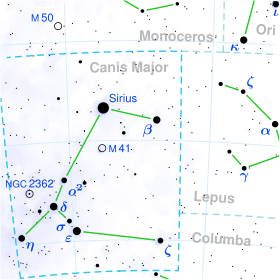
| |
| Observation data Epoch J2000.0 Equinox J2000.0 (ICRS) | |
|---|---|
| Constellation | Canis Major |
| Right ascension | 06 54 13.04410 |
| Declination | −23° 55′ 42.0150″ |
| Apparent magnitude (V) | 6.91 6.71 to 6.95 |
| Characteristics | |
| Spectral type | WN4-s |
| U−B color index | −0.89 |
| B−V color index | −0.28 |
| Variable type | UGZ? |
| Astrometry | |
| Proper motion (μ) | RA: −4.431±0.057 mas/yr Dec.: 2.884±0.092 mas/yr |
| Parallax (π) | 0.4119 ± 0.0503 mas |
| Distance | 4,900 ly (1,500 pc) |
| Absolute magnitude (MV) | −5.33 |
| Orbit | |
| Period (P) | 3.63 d |
| Semi-major axis (a) | 0.13 au |
| Eccentricity (e) | 0.10 |
| Inclination (i) | 74° |
| Details | |
| WR | |
| Mass | 23 M☉ |
| Radius | 3.25 R☉ |
| Luminosity (bolometric) | 620,000 L☉ |
| Temperature | 89,100 K |
| companion | |
| Mass | 1.5 M☉ |
| Other designations | |
| EZ CMa, ALS 98, CD−23°4553, CEL 1426, Collinder 121 4, CPD−23°1588, GC 9061, HD 50896, Hen 3-20, HIP 33165, HR 2583, LBN 1052, MR 6, PPM 251223, SAO 172546, SH 2-308, TYC 6522-3270-1, WR 6 | |
| Database references | |
| SIMBAD | data |
EZ Canis Majoris (abbreviated to EZ CMa, also designated as WR 6) is binary system in the constellation of Canis Major. The primary is a Wolf-Rayet star and it is one of the ten brightest Wolf-Rayet stars, brighter than apparent magnitude 7.
Binary system

L. W. Ross announced his discovery that the star's brightness varies, in 1961. EZ CMa has an apparent visual magnitude which varies between 6.71 and 6.95 over a period of 3.766 days, along with changes in the spectrum. It has been proposed that it could be a binary star, with a neutron star as companion that would complete an orbit around the Wolf-Rayet with that period, being the cause of those variations. The General Catalogue of Variable Stars lists it as a possible cataclysmic variable on this basis. It has been argued that the companion does not exist and spectral variations are caused by activity on the star's surface.

Observations of the light variations over a four-month period from late 2015 to early 2016 confirmed the clear 3.76 d variations. This was interpreted as a 3.66 d orbital period with rapid apsidal precession completing a full rotation in about 100 days. The orbit is inclined at around 60–74 degrees and there are two eclipses during each orbit.
Wolf Rayet star and nebula
The spectral type of WN4 indicates an extremely hot star, and this leads to a very high luminosity, mostly emitted as ultraviolet radiation. The spectrum shows a star entirely devoid of hydrogen at the surface.
EZ CMa is surrounded by a faint bubble nebula, a small HII region blown by stellar winds up to 1,700 km/s and ionised by the intense UV radiation. This is catalogued as Sharpless Sh2-308, or just S308. It is likely to be a member of the very scattered open cluster Collinder 121, found around the orange supergiant ο CMa.
References
- ^ Van Leeuwen, F. (2007). "Validation of the new Hipparcos reduction". Astronomy and Astrophysics. 474 (2): 653–664. arXiv:0708.1752. Bibcode:2007A&A...474..653V. doi:10.1051/0004-6361:20078357. S2CID 18759600.
- ^ Ducati, J. R. (2002). "VizieR Online Data Catalog: Catalogue of Stellar Photometry in Johnson's 11-color system". CDS/ADC Collection of Electronic Catalogues. 2237: 0. Bibcode:2002yCat.2237....0D.
- ^ Samus, N. N.; Durlevich, O. V.; et al. (2009). "VizieR Online Data Catalog: General Catalogue of Variable Stars (Samus+ 2007–2013)". VizieR On-line Data Catalog: B/GCVS. Originally Published in: 2009yCat....102025S. 1: 02025. Bibcode:2009yCat....102025S.
- ^ Sota, A.; Maíz Apellániz, J.; Morrell, N. I.; Barbá, R. H.; Walborn, N. R.; Gamen, R. C.; Arias, J. I.; Alfaro, E. J.; Oskinova, L. M. (2019). "The Galactic WN stars revisited. Impact of Gaia distances on fundamental stellar parameters". Astronomy & Astrophysics. A57: 625. arXiv:1904.04687. Bibcode:2019A&A...625A..57H. doi:10.1051/0004-6361/201834850. S2CID 104292503.
- ^ Brown, A. G. A.; et al. (Gaia collaboration) (August 2018). "Gaia Data Release 2: Summary of the contents and survey properties". Astronomy & Astrophysics. 616. A1. arXiv:1804.09365. Bibcode:2018A&A...616A...1G. doi:10.1051/0004-6361/201833051. Gaia DR2 record for this source at VizieR.
- ^ Toalá, J. A.; Guerrero, M. A.; Ramos-Larios, G.; Guzmán, V. (2015). "WISE morphological study of Wolf-Rayet nebulae". Astronomy & Astrophysics. 578: A66. arXiv:1503.06878. Bibcode:2015A&A...578A..66T. doi:10.1051/0004-6361/201525706. ISSN 0004-6361. S2CID 55776698.
- ^ Schmutz, W.; Koenigsberger, G. (2019). "Long uninterrupted photometric observations of the Wolf-Rayet star EZ CMa by the Toronto BRITE satellite reveal a very fast apsidal motion". Astronomy & Astrophysics. 624: L3. arXiv:1903.09501. Bibcode:2019A&A...624L...3S. doi:10.1051/0004-6361/201935094. S2CID 85459362.
- Van Der Hucht, Karel A. (2001). "The VIIth catalogue of galactic Wolf–Rayet stars". New Astronomy Reviews. 45 (3): 135–232. Bibcode:2001NewAR..45..135V. doi:10.1016/S1387-6473(00)00112-3.
- Ross, L. W. (October 1961). "Variability in Wolf-Rayet Stars". Publications of the Astronomical Society of the Pacific. 73 (434): 354–357. Bibcode:1961PASP...73..354R. doi:10.1086/127710. Retrieved 1 January 2025.
- ^ St-Louis, Nicole; Dalton, M. J.; Marchenko, S. V.; Moffat, A. F. J.; Willis, A. J. (1995). "The [ITAL]IUE[/ITAL] Mega Campaign: Wind Structure and Variability of HD 50896 (WN5)". The Astrophysical Journal. 452. Bibcode:1995ApJ...452L..57S. doi:10.1086/309706. S2CID 117990494.
- "MAST: Barbara A. Mikulski Archive for Space Telescopes". Space Telescope Science Institute. Retrieved 8 December 2021.
External links
- NASA Astronomy Picture of the Day: Sharpless 308 (23 April 2009)
- NASA Astronomy Picture of the Day: Sharpless 308: Star Bubble (23 June 2015)
| Constellation of Canis Major | |||||||||||||
|---|---|---|---|---|---|---|---|---|---|---|---|---|---|
| Stars |
| ||||||||||||
| |||||||||||||
| Star clusters |
| ||||||||||||
| |||||||||||||
| Galaxies |
| ||||||||||||
| |||||||||||||